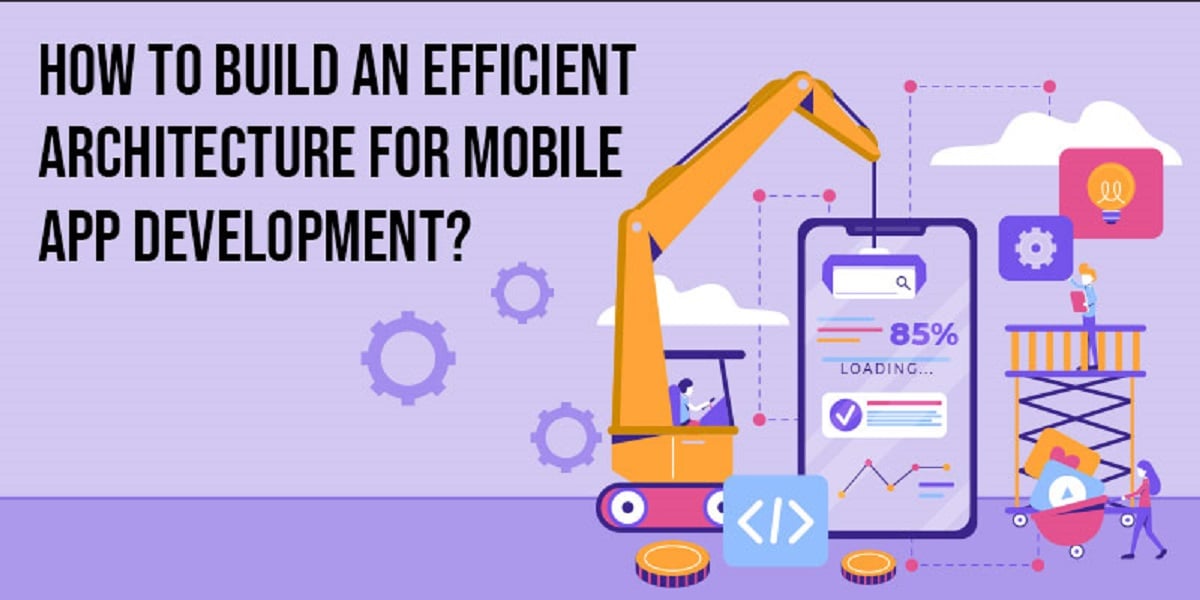How To Build An Efficient Architecture For Mobile App Development?
- By Sumedha
- 21-09-2021
- Mobile App Development

Ever since their inception, mobile apps have significantly changed our lives. Whether it is for business expansion or our daily tasks, mobile applications have become our lifesaver. Moreover, in today’s pandemic-ridden world, mobile apps are being used to their full potential as the world is limited to their homes.
As far as architecture for mobile app development is concerned, businesses cannot become satisfied because the business world is extremely dynamic and progressing rapidly. Therefore, if you do not keep up with changing trends, you will not get the results you want for your business.
So, in order to face direct competition, a company must be well versed in the architecture of mobile applications. And if the architecture does not meet the standard, the entire mobile app development process will go nonfunctional. So let’s start with understanding what precisely mobile app architecture is?
What Is Mobile App Architecture?
Mobile architecture is a set of guidelines, patterns, and techniques to build a mobile application. This set of rules allows the development of well-structured and logical mobile applications that meet with customers’ expectations and business standards.
Many characteristics affect the development of excellent mobile architecture, like the type of mobile platform, speed of internet connection, type of device, potential mobile device features – CPU loading, resolution, screen size, and many others.
Once you understand what features you want to implement in the application, you can prepare the layout of mobile app architecture that binds these required features together into one application. An app’s efficiency, scalability, accessibility, and other factors rely on thorough execution of the development architecture.
The Layers of Mobile App Architecture Design
The three-layer architecture is the standard multilayer architecture of mobile applications. It is essential for creating app architecture. It denotes your component’s internal architecture. Here are the three most crucial layers of mobile architecture design:
Presentation Layer
The presentation layer involves two elements. These two elements consist of the UI and User Interface procedure. The primary focus while discussing this layer is the end-user mobile app presentation. Throughout the presentation layer stage, you must choose many essential features, including themes, colors, fonts, and shadings.
The app developers should remember the client’s deployment restriction while designing mobile app architecture. Another necessity of this layer is to select the precise data format and use robust data validation mechanisms.
Business Layer
This layer is for the components on the business front. The business layer looks at how the application will represent the business to the end-users. It involves business components, objects, and workflow. This layer is more complex as compared to other layers. The security challenges and exception management enhance its complexity.
To reduce its complexity, it includes two parts - the service layer and the domain model. The service layer is used for standard application function sets. In contrast, the domain model is used for knowledge and proficiency associated with particular problems.
Data Access Layer
This layer complies with the app requirements to enable secured data transactions. However, it would be best if you designed this dimension to be rescaled over time as the business needs transformation. It combines different sections, including data access components, data utilities, and service agents.
To design a data access layer, having a solid validation technique is necessary. Also, the selection of the proper data format is crucial.
Building The Ultimate App Architecture
Building good app architecture is vital for any business, here are few considerations you need to check at the time of building mobile app architecture:
1. Determining The Device
It would be best to keep the device types in mind, including the screen size, CPU characteristics, resolution (DPI), storage space and memory, and development tool accessibility. In addition, the features in the application might have special requirements from hardware or software; this is why you need to know devices that the app will support when building app architecture.
2. Considering Bandwidth
There are times when connectivity is either irregular or not accessible. Therefore, to build your app architecture, you need to consider the worst network scenarios. Accordingly, design your caching, state management, and data access mechanism considering times of irregular connectivity.
3. Defining User Interface
You have the entire future ahead to show your creativity. So do not pour it all at the very first stage. It has been suggested to Keep your user interface as simple as possible. It has been noticed that a cluttered UI becomes a major reason behind a mobile application’s failure.
4. Navigation methods
There are numerous ways to navigate through app features, and you must evaluate which is good for your mobile application. The list includes:
Single view
Gesture-based
Model controller
Stacked navigation Bar
Search driven
Tab controller
Scroll views
Understand your customers and the app requirement; choose the navigation method that directly impacts your user experience.
Conclusion
Mobile app architecture is one of the most important factors in the success of any mobile application. Therefore, it’s crucial to carefully evaluate what features you want to integrate in your mobile app, how to implement them, and how to deploy them in the architecture.
The selection of the right mobile app architecture depends on various factors like end-users, variety of mobile platforms, and resources available. It can be challenging to keep all these aspects in mind when planning your mobile application. Therefore, it would be best to consult a reputed mobile app development company, which will help you with the most effective ways to develop your app.


.jpg)


